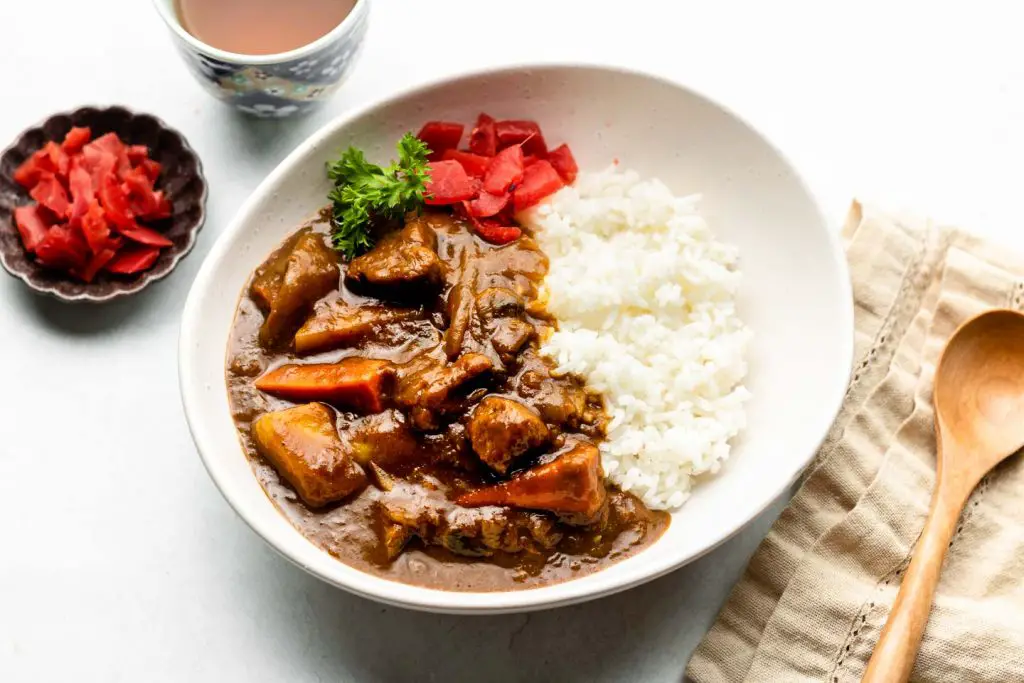Japanese curry is a popular dish that originated from India and was introduced to Japan by the British in the late 1800s. Over time, it has become a staple in Japanese cuisine and can be found in almost every household. The creamy, flavorful and slightly sweet taste of Japanese curry makes it a favorite among both locals and tourists.
However, one common complaint about Japanese curry is its thin consistency. Many people prefer a thicker and richer texture, similar to that of a stew. In this guide, we will explore different methods on how to thicken Japanese curry without compromising its taste.
Thicken Japanese Curry Nutrition Facts:
Before we dive into the methods, let’s take a look at the nutrition facts of Japanese curry. A basic serving size of 100g contains approximately 150 calories, with 7 grams of fat and 19 grams of carbohydrates. It also provides a good amount of iron, vitamin C, and potassium.

Why Is My Japanese Curry Thin?
The main reason for the thinness of Japanese curry is due to the use of roux or premade curry blocks. These pre-packaged ingredients are convenient and easy to use, but they often contain thickeners such as cornstarch or flour to give the curry a smooth texture. However, these thickeners can only do so much and may not be enough for those who prefer a thicker consistency.
Another factor that contributes to thin Japanese curry is the amount of liquid added during the cooking process. Some recipes call for more water or broth to create a soup-like consistency, resulting in a thinner curry.
How to thicken Japanese curry
There are various methods you can try to achieve a thicker and more satisfying Japanese curry. Let’s take a look at some of them.
1. Cornstarch Slurry
One of the simplest ways to thicken Japanese curry is by using a cornstarch slurry. To make the slurry, mix equal parts of cornstarch and water until it forms a smooth paste. Then, add the slurry to the curry while it’s still hot and stir until it thickens. Keep in mind that a little goes a long way, so start with a small amount and gradually add more as needed.
2. Potato Starch
Similar to cornstarch, potato starch can also be used as a thickening agent for Japanese curry. Mix 1-2 tablespoons of potato starch with cold water and add it to the curry while it’s boiling. Stir continuously until the desired thickness is achieved.
3. Mashed Potatoes
If you want to incorporate more potatoes into your dish, you can also use mashed potatoes as a thickener for Japanese curry. Simply boil and mash some potatoes, then add them to the curry while it’s cooking. The starch in the potatoes will help thicken the curry and also add a creamy texture.
4. Bread Crumbs
Yes, you read that right – bread crumbs can also be used to thicken Japanese curry. Simply add a handful of bread crumbs to the curry while it’s still hot and stir until they dissolve. This method not only thickens the curry but also adds a subtle flavor and texture to the dish.
Ways To Thicken Japanese Curry
1. Adding Potato
Potatoes are a great natural thickener and can be easily found in most households. Simply peel and dice potatoes into small cubes and add them to the curry while it’s cooking. As the potatoes cook, they release starch which helps to thicken the curry. This method not only thickens the curry but also adds a subtle sweetness and texture to it.
2. Making A Slurry
A slurry is a mixture of flour or cornstarch with water that is used as a thickening agent in cooking. To make a slurry, mix equal parts of flour or cornstarch with water until it forms a smooth paste. Add this mixture into the curry while it’s cooking and stir continuously until the desired thickness is achieved.
3. Using Coconut Milk
Coconut milk is commonly used in South East Asian cuisine as a thickening agent. It has a creamy texture and adds a subtle sweetness to curries. Simply add a small amount of coconut milk into the curry while it’s cooking and stir until well combined. Be careful not to add too much as it can overpower the flavor of the curry.
4. Let It Simmer
Sometimes, patience is key when it comes to thickening Japanese curry. After all the ingredients have been added, let the curry simmer on low heat for an additional 10-15 minutes. This will allow the excess liquid to evaporate, resulting in a thicker curry.

Tips for Achieving the Perfect Consistency
- Use less liquid: As mentioned earlier, using less water or broth in the recipe can result in a thicker curry. Start with the recommended amount and adjust as needed.
- Let it simmer: Allowing your curry to simmer for a longer period will help thicken it naturally. Just make sure to stir occasionally and keep an eye on the consistency.
- Make a roux from scratch: Instead of using pre-made roux or curry blocks, you can make a roux from scratch using flour, butter, and spices. This will give you more control over the thickness of your curry.
- Add vegetables: Adding chopped vegetables such as carrots or potatoes can not only add flavor but also thicken the curry as they cook.
- Use a thickening agent: If all else fails, you can always use a commercial thickening agent such as arrowroot powder or xanthan gum. Just be sure to follow the instructions on the packaging.
Other Tips To Consider
- Use a combination of the methods mentioned above for even better results.
- Adjust the amount of water or broth used in the recipe to achieve your desired consistency.
- Be careful not to add too much salt or seasoning when using coconut milk as it may affect the overall flavor of the curry.
- If all else fails, add a premade curry block or roux into the curry towards the end of cooking to thicken it. However, this may alter the taste and authenticity of homemade Japanese curry.
In conclusion, there are various ways to thicken Japanese curry without compromising its taste. Experiment with different methods and find the one that works best for you. With a little creativity and patience, you can enjoy a thick and flavorful Japanese curry in no time. So next time your curry turns out thin, don’t fret – just follow these tips to achieve the perfect texture! Happy cooking!
FAQs:
Q: Can I use any type of flour to make a slurry?
A: Yes, you can use any type of flour such as all-purpose flour, cornstarch, or potato starch.
Q: How long should I let the curry simmer for?
A: This may vary depending on the recipe and ingredients used. Generally, letting it simmer for 10-15 minutes should be enough to thicken the curry.
Q: Can I use other vegetables besides potatoes to thicken the curry?
A: Yes, you can try using carrots, sweet potatoes, or even pumpkin as they also release starch when cooked. However, keep in mind that this may alter the taste of the dish. As always, experiment and see what works best for you.
Q: Can I use other types of milk instead of coconut milk?
A: Yes, you can use heavy cream or Greek yogurt as a substitute for coconut milk. However, the taste and texture may differ from using coconut milk. Adjust the amount used according to your preference.
Q: How do I know when my curry is thick enough?
A: The best way to determine the thickness of your curry is by using a spoon to check its consistency. If it coats the back of the spoon and doesn’t drip off easily, then it’s done. Keep in mind that the curry will thicken more as it cools down. Add more liquid if needed before serving.
Conclusion
In conclusion, there are many ways to thicken Japanese curry and achieve the perfect consistency. From using natural ingredients such as potatoes and coconut milk to making a slurry or letting it simmer, each method has its own unique benefits. It’s important to keep in mind that the thickness of the curry can vary depending on personal preference and recipe variations, so don’t be afraid to experiment and find what works best for you.
No matter which method you choose, remember to always taste and adjust as needed to maintain the flavor balance of your curry. With a little creativity and patience, you can enjoy a thick and flavorful Japanese curry that is sure to impress. We hope these tips have been helpful in enhancing your cooking skills and expanding your culinary repertoire.

William Lariviere is a chef and restaurateur with over 25 years of experience in the food industry. He is the owner and operator of Swartzsdeli.com, an online restaurant that specializes in gourmet sandwiches and salads, grill & smoke. He likes to share experience, food, recipes cooking knowledge as well as reviews about restaurant and kitchen products.
William’s goal is to provide his customers with healthy, delicious food that is also affordable and develop Swartzsdeli.com into a comprehensive information site specializing in cooking and cuisine to a new level to help reach a wide range of housewives and readers.








